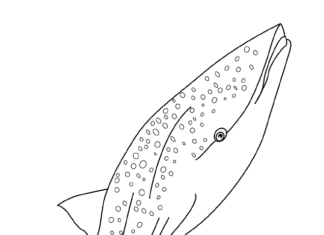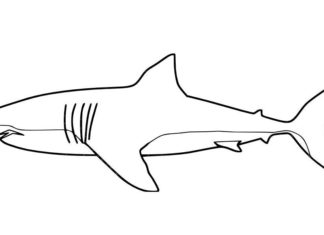Sharks are a group of predatory marine fish that are known for their distinctive body structure, complex sensory system and position at the top of the food chain in marine ecosystems.
Shark Coloring Pages
information
- Body structure: Sharks are characterized by an elongated, hydrodynamic silhouette that allows them to swim effectively. Their bodies are covered with hard, fine scales, and many species have unique patterns and colors that aid in camouflage and mimicry.
- Backbone: Sharks have a skeleton made of cartilage, which distinguishes them from most other bony fish, which have a skeleton made of bone.
- Flippers: A distinctive feature of sharks are their fins, including the dorsal fin, pectoral and ventral fins, and caudal fins. The dorsal fin, in some species, may be equipped with a sharp structure called a spike.
- Senses: Sharks have highly developed senses, including smell, sight, hearing and electroreceptors. Smell is especially important to them when foraging for food. Their sense of electroreceptors allows them to detect electric fields generated by aquatic organisms.
- Food: Sharks are mainly predators that prey on various aquatic organisms such as fish, crustaceans, squid and other marine animals.
- Reproduction: Sharks reproduce in different ways. Some are oviparous, laying eggs from which young fish hatch, while others are viviparous and give birth to fully formed young sharks.
- Diversity of species: There are more than 500 species of sharks, varying in size, body shape and behavior. Representatives of this group are found in a variety of marine habitats, from coral reefs to deep ocean waters.
- Threats: Some shark species are threatened with extinction due to overfishing, habitat degradation and trade in their fins. Many species are protected by international and national regulations.
- Myths and Reality: Sharks are often mistakenly perceived as dangerous to humans because of movies and the media. However, most shark species do not pose a threat to humans. Shark attacks on humans are rare and usually result from misunderstandings or mistakes.
- Marine ecosystems: Sharks play an important role in regulating populations of other marine organisms and maintaining a healthy marine ecosystem. They are also the subject of scientific research that helps to better understand marine ecosystems.
trivia
- Biggest shark: The whale shark (Rhincodon typus) is considered the world's largest shark and one of the largest marine animals. It can reach lengths of up to 18 meters.
- Smallest shark: The bamboo shark (Chiloscyllium punctatum) is one of the smaller shark species, reaching a length of about 1 meter. It is a popular aquarium animal.
- Shark fossils: Sharks have existed on Earth for hundreds of millions of years and have survived many climatic and ecological changes. Shark fossils are found all over the world and provide valuable information about the history of marine life.
- Lifespan: Some shark species, such as the Greenland shark (Somniosus microcephalus), can live a very long time. Some individuals reach an age of more than 400 years.
- Bone Bonyification: Some sharks have so-called bony bones, which are similar to those found in bony fish. One example is the white shark.
- Migrating sharks: Many shark species undertake regular long-distance migrations. The whale shark, for example, travels thousands of kilometers along the oceans in search of food.
- Sharks in health care: Researchers inspired by the unique structure of shark skin are working to create dressing materials and antibacterial coatings that can reduce the risk of infection.
- Sense of electroreceptors: Sharks have electroreceptors called Lorenzini ampullae, which allow them to detect electric fields generated by aquatic organisms. This helps them search for prey even in difficult visibility conditions.
- Ruthless hunters: Sharks are known for their role as marine predators and are effective hunters. Their senses and speed make them excellent predators in marine environments.
- Valuable fishing industry: Sharks are an important source of commercial fisheries, providing meat, fins, skin and other products. However, overfishing of sharks poses a threat to many species populations.
















